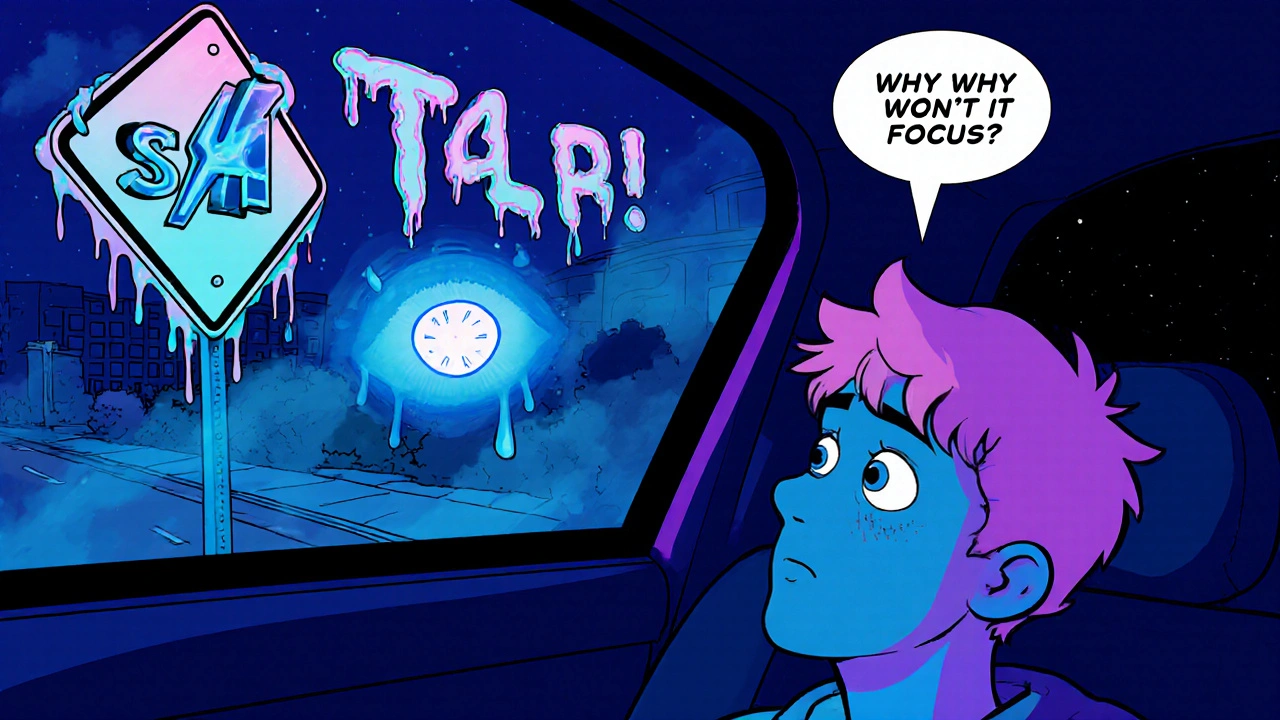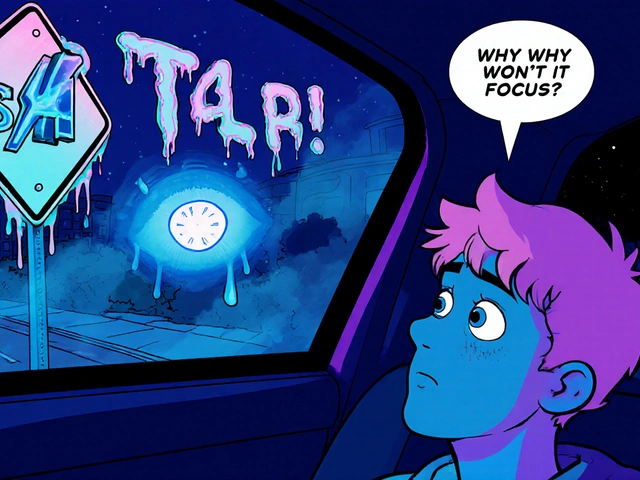Imagine looking at a street sign, but the letters keep bending and blurring-no matter how hard you squint. That’s what many people with keratoconus experience daily. It’s not a simple case of needing stronger glasses. The cornea, the clear front surface of your eye, starts to thin and bulge outward into a cone shape. This isn’t just a minor distortion-it changes how light enters your eye, scrambling your vision. For most, the solution isn’t surgery right away. It’s something simpler, yet surprisingly powerful: rigid contact lenses.
What Actually Happens When the Cornea Thins?
Keratoconus doesn’t strike suddenly. It creeps in, usually during the teens or early 20s. The cornea, normally smooth and dome-shaped, begins to weaken. Enzymes in the eye break down its structural fibers faster than the body can repair them. The result? Progressive thinning, especially in the center or lower part of the cornea. This part bulges out like a small cone, creating severe irregular astigmatism. Vision becomes blurry, double, or distorted. Glare and light sensitivity get worse, especially at night.It’s often worse in one eye than the other. People think they’re just getting worse eyesight, so they keep getting stronger glasses. But glasses can’t fix an irregular surface. They only bend light evenly. When the cornea is warped, you need something that can override that shape entirely. That’s where rigid lenses come in.
Why Rigid Lenses Work When Glasses Fail
Soft contact lenses conform to the shape of your cornea. If the cornea is cone-shaped, the soft lens just follows along-and so does the blurry vision. Rigid gas permeable (RGP) lenses don’t do that. They’re hard. They keep their shape. When you put one on, it sits on top of the irregular cornea and creates a new, perfectly smooth optical surface. Tears fill the tiny gap between the lens and your eye, acting like a liquid buffer. Light now passes through this smooth, uniform surface, not the warped cornea beneath. The outcome? Sharp, clear vision.Studies show that after fitting, visual acuity jumps from an average of 20/400 (legally blind) to 20/200 or better in most cases. For many, it improves further to 20/25-close to normal. That’s not a small gain. It’s the difference between driving safely and not being able to read the dashboard.
The Three Types of Rigid Lenses Used for Keratoconus
Not all rigid lenses are the same. There are three main types used today:- RGP lenses: These are the traditional option. They’re small-about 9 to 10 millimeters in diameter-and sit directly on the cornea. They offer excellent vision correction and are often the first choice for early to moderate keratoconus. Oxygen permeability (Dk values) ranges from 50 to 150, which keeps the cornea healthy during wear.
- Hybrid lenses: These combine a rigid center (for clear vision) with a soft outer skirt (for comfort). They’re a good middle ground if RGP lenses feel too uncomfortable but scleral lenses feel like overkill.
- Scleral lenses: These are larger-15 to 22 millimeters-and vault over the entire cornea, landing on the white part of the eye (sclera). They create a fluid reservoir between the lens and the cornea, which not only improves vision but also protects the thinning surface. They’re the go-to for advanced cases, scarring, or when RGP lenses won’t fit properly.
According to clinical data, scleral lenses have an 85% success rate in stage III-IV keratoconus, compared to 65% for RGP lenses. That’s a big difference when your vision is on the line.

How Fitting Works-and Why It Takes Time
You can’t just walk into a store and buy these lenses. Fitting requires specialized equipment. A corneal topographer maps your eye’s shape in detail, creating a 3D image of the cone. Based on that, the lens is custom-designed or selected from a set of trial lenses. It’s not a one-visit process. Most patients need 3 to 5 appointments over 4 to 6 weeks.Initial wear starts with just 2 to 4 hours a day. You slowly build up, adding an hour or two each day. It takes 2 to 4 weeks for most people to adapt. About 30% feel discomfort at first-burning, foreign body sensation, or just awareness of the lens. But 85% of patients who stick with it achieve full-time, comfortable wear.
Learning to insert and remove the lenses takes practice. Cleaning is critical. Dust, protein buildup, or improper solutions can cause fogging or irritation. About 25% of users report lens fogging early on. Switching to preservative-free rewetting drops or a different cleaning solution usually fixes it.
What About Other Treatments? Cross-Linking, INTACS, Transplants
Rigid lenses don’t stop keratoconus from getting worse. They only fix the vision. To stop progression, you need corneal cross-linking (CXL). This FDA-approved procedure uses UV light and riboflavin (vitamin B2) to strengthen the corneal fibers. It halts progression in 90-95% of cases. But it doesn’t improve vision-you still need lenses after.INTACS are tiny plastic rings inserted into the cornea to flatten the cone. They help some, but 35-40% of patients still need rigid lenses afterward. Corneal transplants (PK or DALK) are reserved for the 10-20% who can’t tolerate lenses or have severe scarring. Recovery takes over a year. Rejection risk is 5-10%. It’s a last resort.
Most experts agree: start with rigid lenses and add CXL if needed. The two work together. Lenses give you sight. CXL protects your future sight.
Who Struggles With Rigid Lenses-and Why
Not everyone succeeds. About 15-25% of patients with advanced keratoconus can’t get a good fit. Reasons include extreme irregularity, corneal scarring, or chronic dry eye. In those cases, scleral lenses often succeed where RGP lenses fail.Another issue: cost and access. Scleral lenses can cost $800-$2,000 per pair and last 1-3 years. Insurance doesn’t always cover them. Finding a specialist who fits them isn’t easy. Only about 350 clinics in the U.S. are certified for advanced scleral lens fitting, like the PROSE system.
Still, 70% of diagnosed patients achieve long-term success with rigid lenses. That’s more than two out of three people who avoid surgery and regain normal function.

What’s New in Rigid Lens Technology?
The field is moving fast. In 2022, manufacturers introduced scleral lenses with oxygen permeability over 200-far higher than older models. That means less risk of corneal swelling, even with all-day wear. In January 2023, the FDA approved the first digital manufacturing process for scleral lenses. Now, lenses are designed using AI-powered topography scans, matching the exact shape of your eye down to microns.More than 78% of cornea specialists now combine CXL with rigid lenses from day one. That’s the new standard. It’s not just about seeing better today-it’s about protecting your eyes for the next 20 years.
Real Outcomes: What Patients Actually Say
Patients who adapt often say things like: “I can read my phone again.” “I drove to work for the first time in years.” “I stopped avoiding bright lights.”One patient in Manchester, diagnosed at 22, started with RGP lenses. After three months, she switched to sclerals. Her vision went from 20/80 to 20/25. “I didn’t realize how much I’d been missing,” she said. “Now I see my granddaughter’s face clearly.”
Another, a teacher in his 40s, struggled with lens insertion for weeks. He nearly gave up. Then he found a specialist who adjusted the edge design. Now he wears them 12 hours a day. “It’s not perfect,” he says. “But it’s my life back.”
What to Do If You Suspect Keratoconus
If you’re under 30 and your vision keeps worsening despite new glasses, get checked. Early diagnosis matters. If caught early, CXL can stop it before major thinning happens. If you’re already diagnosed and struggling with glasses or soft contacts, talk to a cornea specialist-not just any optometrist. Ask about corneal topography and rigid lens options.Don’t wait until you’re barely seeing. Rigid lenses aren’t glamorous. They require effort. But for most people with keratoconus, they’re the bridge between blurred vision and a normal life.
Can glasses fix keratoconus?
No. Glasses correct regular refractive errors like nearsightedness or standard astigmatism. Keratoconus causes an irregularly shaped cornea, which glasses can’t compensate for. Vision remains blurry or distorted even with the strongest prescription. Rigid contact lenses are needed to override the irregular surface and restore clear vision.
Do rigid lenses stop keratoconus from getting worse?
No. Rigid lenses only correct vision-they don’t treat the underlying thinning. To stop progression, you need corneal cross-linking (CXL), a medical procedure that strengthens the corneal tissue. Most experts recommend combining rigid lenses with CXL for both immediate vision improvement and long-term disease control.
How long does it take to get used to rigid lenses?
Most people adapt in 2 to 4 weeks. Start with 2-4 hours of wear per day and increase by 1-2 hours daily. Initial discomfort is common-about 45% feel a foreign body sensation, and 32% struggle with insertion. But 85% of patients who persist reach full-time, comfortable wear.
Are scleral lenses better than RGP lenses for keratoconus?
It depends on the stage. For early to moderate cases, RGP lenses often work well and are easier to fit. For advanced cases, scarring, or intolerance to RGP lenses, scleral lenses are superior. They vault over the cornea, offering better comfort and stability. Success rates are 85% for scleral lenses in stage III-IV, compared to 65% for RGP lenses.
Is surgery always needed for advanced keratoconus?
No. Only 10-20% of patients eventually need a corneal transplant. Most can manage with advanced rigid lenses-especially scleral lenses-and cross-linking. Surgery is reserved for those who can’t tolerate lenses, have severe scarring, or experience lens intolerance despite multiple fittings.







Miriam Lohrum
November 26, 2025 AT 22:46It’s fascinating how something so simple-a hard little disc of plastic-can restore a person’s entire relationship with the world. We think of vision as passive, but it’s actually a negotiation between the eye and the environment. Rigid lenses don’t just correct light; they rewrite the rules of perception. And yet, we still treat them like a last resort, not a breakthrough.
Maybe it’s because they’re not glamorous. No lasers. No implants. Just tears, patience, and a lot of fumbling with tweezers. But isn’t that the hallmark of real medicine? Not the spectacle, but the quiet persistence.
I wonder how many other conditions are treated this way-where the solution is mechanical, humble, and deeply human, but gets overshadowed by flashy tech.
Rhiana Grob
November 28, 2025 AT 11:07I appreciate the thoroughness of this post. The distinction between vision correction and disease modification is critical, and too often conflated. Cross-linking is not a cure, but it is a stabilization-a vital pause in the progression of a condition that can otherwise lead to irreversible damage.
It’s also worth noting that access to these lenses remains a systemic issue. The cost, the specialist requirements, and the insurance barriers disproportionately affect low-income communities. We can celebrate the technology, but we must also demand equitable distribution.
For those who have found relief, I’m genuinely happy for you. For those still struggling to find a fitter, you are not alone-and your vision matters just as much.
Edward Batchelder
November 29, 2025 AT 00:13Let me tell you something: I’ve spent 12 years working with people who have keratoconus, and I’ve seen every kind of reaction-from despair to euphoria. But the one thing that never changes? The moment they see their grandchild’s face clearly for the first time in years. That’s not a medical statistic. That’s a soul reconnected.
Rigid lenses aren’t perfect. They’re not easy. They require discipline, hygiene, and patience. But they’re not a compromise. They’re a restoration. And every single person who sticks with them, who pushes through the discomfort, who learns to insert them without crying-those people are warriors.
And yes, the cost is outrageous. And yes, there aren’t enough specialists. But if you’re reading this and you’re struggling? Don’t give up. Find the next clinic. Call three more. Keep going. Your vision is worth it.
Also, if you’re a doctor reading this: please, please, please refer early. Don’t wait until the cornea is scarred. Early CXL + lenses = lifelong vision. It’s not rocket science. It’s basic care.
reshmi mahi
November 30, 2025 AT 21:09laura lauraa
November 30, 2025 AT 21:36It’s ironic, isn’t it? That we’ve developed AI-driven, micron-precision lens manufacturing, yet we still treat patients like they’re defective machines that need to be ‘fixed’ rather than individuals whose lived experience is being ignored by a system that prioritizes profit over accessibility.
The fact that 70% succeed is statistically impressive-but what about the 30% who are left behind? Who are they? Are they poor? Are they elderly? Are they undocumented? Are they being told to ‘just endure’ because insurance won’t cover it?
And let’s not pretend that ‘adapting’ to discomfort is a virtue. It’s a symptom of systemic neglect. We celebrate resilience while ignoring the structures that demand it.
Also, the phrase ‘bridge between blurred vision and a normal life’ is dangerously romantic. What if ‘normal’ is a myth? What if the real problem isn’t the cornea, but a society that equates vision with worth?
I’m not saying the lenses are bad. I’m saying the context in which they’re offered is profoundly broken.
Gayle Jenkins
December 2, 2025 AT 04:35Hey, if you’re reading this and you’ve been told ‘you’ll never drive again’ or ‘your vision is too bad for contacts’-I’m here to tell you: you’re wrong.
I had keratoconus diagnosed at 19. I cried for weeks. I thought I’d be blind by 30. I tried soft lenses-they felt like sandpaper on my eyeballs. I tried RGP for a month, hated it, almost quit.
Then I found a specialist who actually listened. She changed the edge design. She taught me how to insert them with one hand while watching TV. She didn’t rush me. She gave me options.
Now I wear sclerals 12 hours a day. I drive. I read. I see my dog’s face when he comes to the door.
You can do this. It’s not easy. But it’s possible. And you deserve to see clearly.
Message me if you need help finding a fitter. I’ve got a list.
Kaleigh Scroger
December 3, 2025 AT 02:39Elizabeth Choi
December 3, 2025 AT 18:09Let’s be honest: 70% success rate sounds good until you realize that’s 30% of people who are left with no viable option, forced into transplants or chronic discomfort.
And let’s not ignore the psychological toll. The lens insertion anxiety. The fear of losing them. The shame of admitting you can’t manage them. The social isolation from avoiding bright lights or public spaces.
The post frames this as a triumph. But for many, it’s a daily negotiation with pain, cost, and systemic neglect.
Also, why is the only patient quote from a woman who sees her granddaughter? Why not include a man who lost his job because he couldn’t wear lenses? Or a teenager who dropped out of school? The narrative is too clean. Too curated.
Real progress isn’t just better lenses. It’s better access. Better support. Better acknowledgment of the human cost.